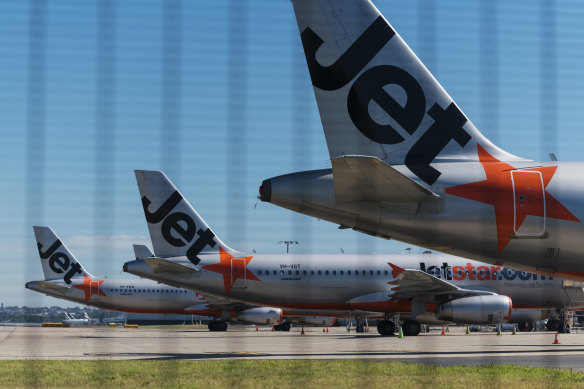
“We try to not even talk about [the COVID-19 recovery period]. I think we all have PTSD. I’m sure there are things about the industry that have changed permanently ... Our workforce is more transient for example, but I think we’re officially stabilised and focussing on growth rather than fixing issues,” she said.
Jetstar is focused on expanding its international market share, traditionally the worst performing part of Australian airlines due to the lower yields and higher costs. Tully said she’s not deterred, that Jetstar has an operating margin of 13 per cent overall and its international arms, Jetstar Asia, Japan and New Zealand are profitable. Jetstar currently flies about 10 per cent of the international market underpinned by its frequent services flying millions of Australians to Bali every year.
Jetstar is trying to increase its international capacity by 30 per cent by the end of this financial year – and by another 25 per cent in the 2025 financial year – and is revamping its fleet of Boeing 787s to do so. If the carrier is successful in its capacity goals, it’ll add another 2 million seats and take the business to 150 per cent of 2019 flying levels.
It’s launched six international routes this year including Sydney to Rarotonga and Melbourne to Fiji. The airline has confirmed another three new routes will be unveiled this month and is considering destinations including Sri Lanka and South Africa to join the previously announced Perth to Phuket, Bangkok and Singapore routes.
Jetstar is also awaiting its twelfth Airbus A321 neo to arrive this month, with 38 A321 neos expected to arrive by 2029 to make up its narrow-body fleet. The global airline industry has been decimated by late orders and parts shortages due to issues at manufacturers Airbus and Boeing and their second and third tier suppliers.
Loading
Tully said engineering teams across the industry have had to work harder than ever to meet delivery timelines: “They’re doing things that were never required before COVID-19 ... They now need better relationships with repair shops who can turn around parts more quickly.
“They have to carry more spares than they’d have to do in the past. They’re constantly looking to Europe and carriers including EasyJet and Ryanair to see how we can get better and stronger at maintenance as well.”
She was appointed chief executive of Jetstar at the end of 2022 after 18 years with the broader Qantas business across its loyalty and marketing divisions. She’s one of the many aviation executives who started her career at Ansett and lost her job when it collapsed in 2001.
At the time Tully took over Jetstar following the departure of industry stalwart Gareth Evans, Jetstar’s cancellation rate was worse than all of its competitors. Half of its long-haul fleet of Boeing 787s were out of operation due to a string of engineering issues which sent its average cancellation rate for the year to above 6 per cent. To make matters worse, its parent group Qantas had plummeted to being one of Australia’s least trusted brands.
Some staff at Jetstar had initial reservations about the idea of a slick Qantas marketing executive swanning in as chief executive at a time when Qantas was so on the nose, but Tully has a frank approachability to her that won people over quickly. More than one staff member said Tully’s approach to the chief executive role can be summed up by her appearance at the airline’s latest Christmas party where she reportedly spent most of the night head-banging to Shannon Noll on the dance floor.

Jetstar is focused on expanding its international market share.Credit: James Brickwood
Tully knows many of the customers who were let down by Jetstar over this period remain reluctant to ever trust it again.
“Jetstar customers don’t often fly as frequently as others. They remember their last experience ... I think when people are flying Jetstar again after a previously challenging experience they probably realise things have changed, but it takes a while for that perception shift to stick.
“I think people get caught up in trying to change brand perception, but you have to deliver. What we do is more important than what we say we’ll do,” she said.
Loading
Tully said the COVID-19 recovery hurt Jetstar employees even more than its passengers because they lived through the heartache of ruined holidays, reunions and business trips every day – often due through no fault of their own. She travels to Melbourne once a week from her Sydney base and said she always requests to sit in the cockpit to talk to the pilots, a break from the usual airline executive routine of rotating through the cabins.
“I came in at a really challenging time. The priority was stabilisation and to stop letting people down but to also fix the morale of our people. Their jobs are better when we’re letting fewer people down. I think you can tell people are back feeling motivated to be here, and it’s pretty happy most days which is a good place to be after the first six or so months,” Tully said.
She admitted she was initially hesitant to take over Jetstar after so many years working on the Qantas brand. “I now think Jetstar actually makes me more emotional because every customer that flies with us has a story. They’ve worked hard to get there.
“There was a 56-year-old man on my flight to Cairns a few weeks ago that was flying for the first time, and he’d saved up so much and was so excited to go on his boys weekend and catch the first flight of his life,” Tully said.
“We can’t ever take that for granted and that’s why it hurts so much when you let people down.”
The Business Briefing newsletter delivers major stories, exclusive coverage and expert opinion. Sign up to get it every weekday morning.









 Add Category
Add Category